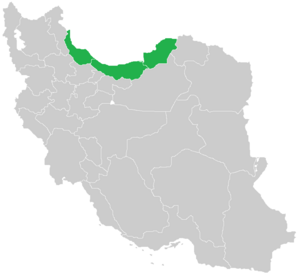Caspian cuisine facts for kids
Caspian cuisine is a special way of cooking food found in Northern Iran. It's mainly popular in the Mazandaran, Gilan, Alborz, and Golestan provinces. The dishes are very different, just like the landscapes of these regions.
Northern Iran has a mix of coasts, plains, forests, and even rainforests. This means the food from the coastal areas is quite different from the food in the mountainous regions. People living near the mountains often use local herbs. Those by the coast use fresh fish and Caspian (Mazani) rice with vegetables.
Contents
History of Caspian Food
The Mazandaran Province is located east of Iran's Gilan. The southern coast of the Caspian Sea is often called the "fertile Caspian provinces." This area grows a lot of citrus fruits, especially oranges, which influence the local cooking.
Historically, rice was a common food only in Mazandaran and Gilan Provinces. Here, rice is cooked in a special way called kateh. This is different from the polos/chelo style found in other parts of Iran. Rice crops grow on the slopes of the Alborz mountain range, which includes parts of Mazandaran Province.
Seafood is a big part of coastal Mazandarani cooking and appears in many meals. Persian caviar (fish eggs) is used in dishes and often served with egg dishes. These egg dishes are sometimes like a frittata or omelette. From the 1400s to 1870, Mazandaran Province was the only place growing sugarcane. People sometimes ate it with bread and rice.
Special Herbs and Health
Some local, wild herbs used in Mazandarani cooking include zolang, anarijeh, ouji, and sersem. These herbs are not well-known outside the Mazandaran Province. Some people believe that certain local dishes and herbs can help with illnesses. Because of this, scholars visit Mazandaran province every year to study these wild herbs and regional dishes.
Stinging nettles grow throughout the province in springtime. A Mazandarani nettle soup is made from them. Nettles are thought to have medicinal benefits, like helping blood and improving hay fever.
Tasty Dishes of Northern Iran
This is a list of some popular dishes from Northern Iran. They are mainly found in the Mazandaran, Gilan, Alborz, and Golestan provinces. Because of the landscape, seasons, and native plants, these regions share similar traditional dishes. However, their cooking history is unique compared to other parts of Iran.
- Aghouze-Messeama
- Dewpetti
- Ispina-Saek
- Khali Aush (Keahi-Esh, a type of soup or stew)
- Naz Khatun (Naz-Xatune)
- Ispinej-Mearji
- Keahi-Heali
- Mirza Ghasemi
- Baghali ghatogh (bean stew) – This stew is usually made in Iran with a bean called "pacheh baghali" (Rashti fava beans). Outside of Iran, it can be made with lima beans, kidney beans, or fava beans. You can find this dish in all northern regions of Iran, but it's especially linked to Mazandaran and Gilan provinces.
- Kateh (rice cooked in water) – This is a typical way of cooking rice in Northern Iran (Mazandaran, Gilan, and Golestan provinces). This rice is made with more water, butter, and salt, using a specific cooking method.
- Keshmesh polo (raisins in rice) – This dish is now found all over Iran, but it first came from northern Iran.
- Khoresh-e gol dar chaman (broad bean stew) – A stew made with garlic, dill, lamb, and broad beans. You can also use fava beans instead of broad beans.
- Khoresh-e torsh tareh (stew of herbs, garlic, and eggs).
- Kuku eshpel (a kuku egg dish made with fish roe or caviar).
- Morgh-e torsh (sour chicken).
- Sirabij (scrambled eggs with chopped and fried garlic leaves) – Found in Mazandaran and Gilan provinces.
- Sir Anar (meaning "garlic pomegranate") – A stew or sauce used with meats.
Sweet Treats
- Aghouzenoon
- Peshtizik
- Pisgendela
- Nesseri
- Kunak
- Tunsernun
- Red sugar (Serkh seker)
- Reshteh Khoshkar
Drinks
Historically, traditional wines in Mazandaran and Gilan were made from wild, local grapes.
Mazandarani people used to drink a traditional wine called Narenj Vehar after hard work. This was especially true during summer and the Merdal month of the Tabarian Calendar. It's a cold drink believed to help people get their energy back.
See also
 In Spanish: Gastronomía de Mazandar%C3%A1n para ni%C3%B1os
In Spanish: Gastronomía de Mazandar%C3%A1n para ni%C3%B1os


